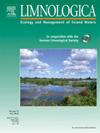The first eco-assessment of thirteen lakes in the Lake Van Basin of Türkiye with phytoplankton metrics as indicators of environmental conditions
IF 2
4区 环境科学与生态学
Q2 LIMNOLOGY
引用次数: 0
Abstract
Lakes are increasingly vulnerable to anthropogenic pressures such as pollution, eutrophication, and climate change, leading to biodiversity loss and ecosystem degradation. This study employed phytoplankton-based metrics across two hydrological periods to evaluate species-environment interactions and assess the ecological status of thirteen lakes in the Lake Van Basin. Canonical correspondence analysis (CCA) showed a strong correlation (96.7 %) between phytoplankton assemblages and environmental stressors. The most influential factors affecting phytoplankton distribution were conductivity, total organic carbon, total suspended solids, total phosphorus, total nitrogen, and nitrate. The CCA clearly distinguished the soda lakes, Lakes Erçek and Sodalı, which were characterized by high conductivity, alkaline pH, and high total organic carbon, and hosted assemblages dominated by taxa tolerant to organic pollution and salinity. In contrast, Lake Hıdırmenteş supported phytoplankton communities adapted to elevated nutrient and turbidity levels, while the Ahlat Marshes were associated with species indicative of nitrogen enrichment. The MPTI−modified phytoplankton trophic index proved to be an effective tool for ecological assessment, showing a strong correlation with total phosphorus (r = 0.925, p < 0.01). The MPTI indicated that Lakes Nemrut, Aygır, and Nazik had a high ecological status, whereas Lakes Erçek, Hıdırmenteş, and Adırum showed a poor status and Lakes Turna and Hasantimur had a moderate one. This first eco-assessment of the region underscores the value of phytoplankton as sensitive indicators of environmental stress and supports the application of the MPTI for ecological status classification in saline and freshwater lakes of the Lake Van Basin.
以浮游植物指标作为环境条件指标,首次对云南凡湖盆地13个湖泊进行生态评价
湖泊越来越容易受到污染、富营养化和气候变化等人为压力的影响,导致生物多样性丧失和生态系统退化。本研究采用基于浮游植物的指标,跨越两个水文期,评估了凡湖流域13个湖泊的物种-环境相互作用和生态状况。典型对应分析(Canonical correspondence analysis, CCA)表明,浮游植物组合与环境胁迫因子的相关性为96.7 %。影响浮游植物分布的主要因子是电导率、总有机碳、总悬浮物、总磷、总氮和硝酸盐。CCA清晰地区分出了高导电性、碱性、高总有机碳含量的苏打湖、erek湖和sodali湖,这些湖泊以耐有机污染和耐盐的类群为主。相比之下,Hıdırmenteş湖支持适应高营养和浊度水平的浮游植物群落,而Ahlat沼泽则与指示氮富集的物种相关。MPTI−修正后的浮游植物营养指数与总磷具有较强的相关性(r = 0.925,p <; 0.01),是一种有效的生态评价工具。MPTI结果表明,Nemrut湖、Aygır湖和Nazik湖生态状况较高,erpaderek湖、Hıdırmenteş湖和Adırum湖生态状况较差,Turna湖和Hasantimur湖生态状况中等。该地区的首次生态评价强调了浮游植物作为环境胁迫敏感指标的价值,并支持MPTI在凡湖盆地咸水湖和淡水湖生态状况分类中的应用。
本文章由计算机程序翻译,如有差异,请以英文原文为准。
求助全文
约1分钟内获得全文
求助全文
来源期刊

Limnologica
环境科学-湖沼学
CiteScore
3.70
自引率
5.90%
发文量
64
审稿时长
3 months
期刊介绍:
Limnologica is a primary journal for limnologists, aquatic ecologists, freshwater biologists, restoration ecologists and ecotoxicologists working with freshwater habitats.
 求助内容:
求助内容: 应助结果提醒方式:
应助结果提醒方式:


